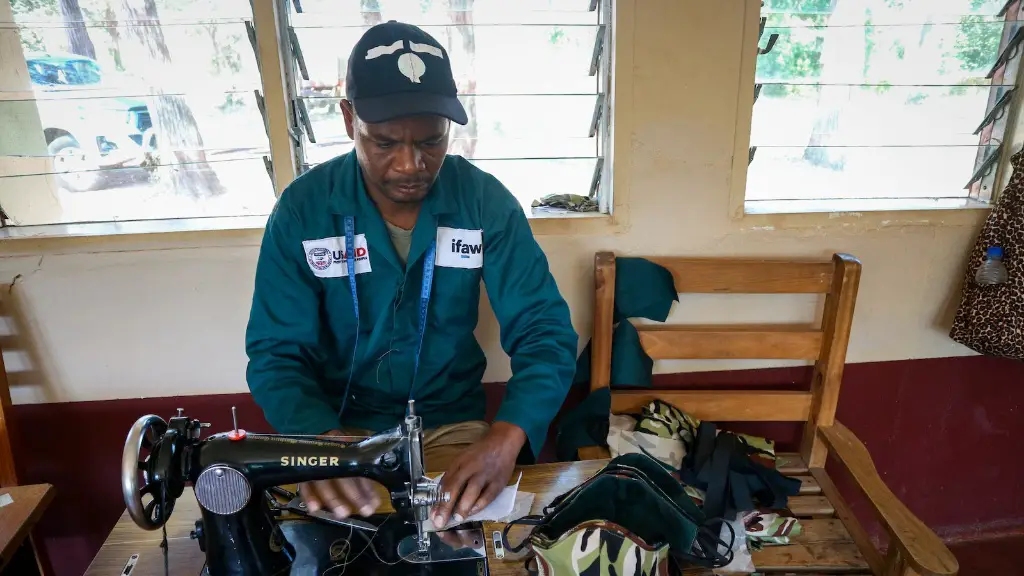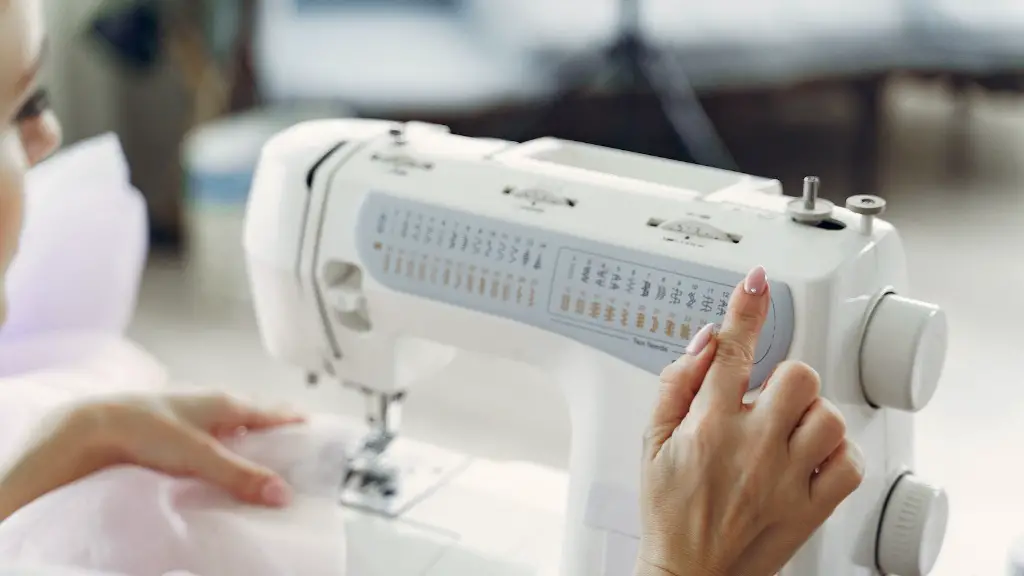Task One: Oiling your Sewing Machine
Most sewing machines need to be oiled regularly in order to ensure smooth and consistent operation. This article will explain the ins and outs of oiling your sewing machine, including what type of oil you should use, how often you should oil it, and any caution areas to be aware of.
When it comes to the type of oil used, it is important to use a high-quality lubricating oil specifically designed for sewing machines. Generally, this oil is designed to be thin and clear, allowing it to penetrate deep into the hard to reach parts of the machine. Many popular brands, such as Singer and Janome, also sell their own brand of sewing machine oil.
With regard to lubrication frequency, the manufacturer’s guidelines should be followed as each machine is different. Most machines will need to be serviced annually and the oil changed each time. However, it is also important to oil your machine more frequently at least once every couple of weeks, or after every use, in order to keep it at peak efficiency.
A few areas to be aware of when oiling a sewing machine are the bobbin case, needle plate, feed dog and bobbin area. These areas can be very sensitive and some may have plastic components. It is therefore important to be careful when oiling, and to avoid spilling or splashing oil onto these components.
The oil should also be applied carefully and sparingly. To do this, fill a saucepan about halfway with oil, dip a cotton cloth in it and then rub the cloth over all the oil points in your machine. Take extra care when oiling any exposed parts such as gears and pulleys as these might need more frequent lubrication than other parts.
Finally, it is important to note that any excess oil should be removed using a rag, as it may attract dirt and dust, which can interfere with moving parts. It is also a good idea to spray the machine with a sewing machine lubricant spray following the oiling process.
Task Two: Cleaning the Machine
Sewing machines should also be regularly cleaned in order to maintain their optimal performance. Regular cleaning helps to remove lint and debris, which can accumulate and cause blockage and unnecessary wear on parts.
When it comes to cleaning the machine, the first step is to remove the bobbin and bobbin case, as well as any attachments and presser feet. Then, run a can of compressed air or small vacuum around the bobbin case, bobbin area and machine base, to get rid of any lint and debris. Once this is done, you can replace the bobbin and bobbin case, along with any attachments and presser feet.
Whilst you should never use water for cleaning the machine, you can use a lint-free cloth dampened slightly with rubbing alcohol to wipe down the outside of the machine, as well as any plastic and metal parts. Be sure to also wipe the light and dust trap areas, as these can cause dust and lint build-up.
In addition, it is important to periodically check the hook race for any build-up of lint and dust. To do this, you will need to remove the hook race and use a pointed object, such as a toothpick, to dislodge any build-up. Once this is done, replace the hook race and then vacuum around the hook race, hook needle bar and hook upper drive wheel.
Task Three: Replacing Parts
From time to time, sewing machines parts will need to be replaced. The most common parts that need to be replaced are needle bars, feed dogs, hook drive wheel and hook races. You will know when these parts need replacing when they start to wear down, or when they stop functioning properly.
When it comes to replacing parts, it is important to ensure that the new parts are compatible with your sewing machine. The best way to do this is to consult your manual or contact the manufacturer for advice. It is also important to double-check that the new parts fit tightly and securely before you begin sewing.
Additionally, you may need to align the new parts before use. This can be done by taking a small screwdriver and adjusting the parts slightly until they are positioned correctly. Once this is done, you can oil the new parts as you normally would. Be sure to wipe away any excess oil before using the machine.
Task Four: Troubleshooting and Maintenance
In order to maintain the best possible performance of your sewing machine, it is important to troubleshoot any problems you encounter. This can include issues such as thread tension, needle breaks and jamming.
To begin troubleshooting, consult your manual and see if there are any specific instructions provided. If not, you can also contact the manufacturer or conduct an online search for advice. If the problem is not solved with any of the suggested options, you may need to have the machine serviced by a professional.
Finally, it is important to keep your sewing machine in the best possible condition with regular maintenance. This includes carrying out regular cleaning and oiling, as well as replacing worn-out parts when necessary. Following these guidelines should help ensure that your sewing machine continues to function correctly.
Task Five: Storing the Machine
When it comes to storing a sewing machine, it is important to ensure that it is kept in a dry, dust-free environment. A sewing machine cover is a good way to protect the machine from moisture and dust, as it can keep the machine clean and dry. Additionally, it is advised to keep the machine away from direct sunlight, as this can cause fading and other damage to the machine.
It is also important to remember to remove all attachments, accessories and presser feet from the machine before storing it, as these can cause damage over time. Additionally, it is important to remember to oil the machine before storing it, as this can prevent corrosion.
Finally, it is important to avoid storing the machine in areas of extreme temperatures and humidity, as these can damage the internal components of the machine. It is also a good idea to store the machine at a low altitude, as this can improve its performance.
Task Six: Accessories
When it comes to sewing machines, there are many accessories and attachments available to enhance your sewing experience. This includes items such as spare bobbins, extra needles, spare spools, threaders, oil and lubricants, thread, fabric and needles.
If you are a beginner, you may want to consider purchasing a starter sewing machine kit, which usually includes the essentials such as the machine, needle, bobbin, presser feet, thread and measuring tape. These kits are usually pre-packed and can save a lot of time and money in the long run.
For more experienced sewers, it is a good idea to invest in some specialist attachments and accessories which are designed to help with a range of tasks. These can include an extension table, button hole maker, a quilting guide and a hem guide. Purchasing the right accessories for your machine can help to make the sewing process easier and more efficient.
Task Seven: Sewing Machine Do’s and Don’ts
When using a sewing machine, it is important to follow certain rules in order to ensure the best possible performance. Here are some of the key do’s and don’ts when it comes to using a sewing machine.
When it comes to the do’s, it is important to always use high-quality needles, thread and fabric, and to replace needles regularly. Additionally, it is also important to oil your machine regularly, as well as keep an eye out for any signs of wear and tear. It is also advisable to follow all safety instructions and correctly thread the machine before use.
In terms of the don’ts, it is important to avoid using excessive force or speed, as this can overload and cause damage to the machine. Additionally, it is important to avoid pulling or tugging at fabric and to avoid over-oiling the machine. Finally, it is important to avoid using the wrong needles and thread, as this can cause jamming and other issues.
Task Eight: Sewing Machine Suppliers
When purchasing a sewing machine, it is important to make sure that you are dealing with reputable suppliers. Here are a few of the main suppliers of sewing machines.
Amazon is one of the biggest suppliers of sewing machines, with an extensive range of models, sewing kits and accessories. Sewing Machine Warehouse is another option, offering a selection of sewing machines, parts and accessories to buy both in-store and online. Finally, Brother offers an impressive selection of both consumer and industrial sewing machines.
When selecting a supplier, it is important to make sure that you are buying from a reputable dealer. Be sure to research the company thoroughly and read online reviews from previous customers. Additionally, it is also a good idea to compare prices before making a purchase.





